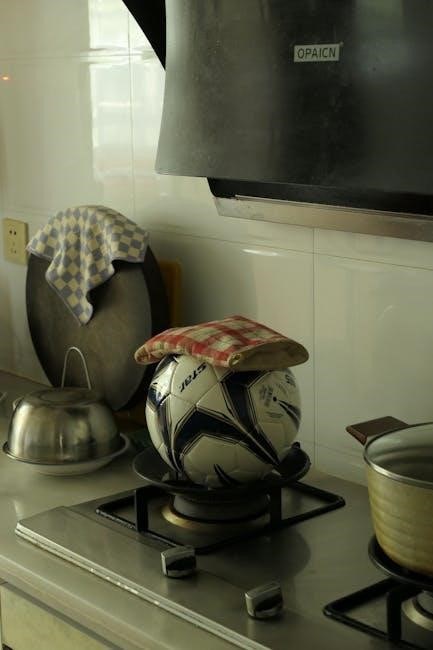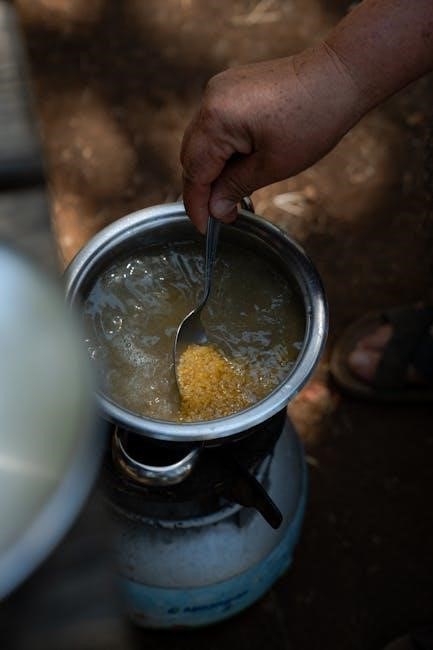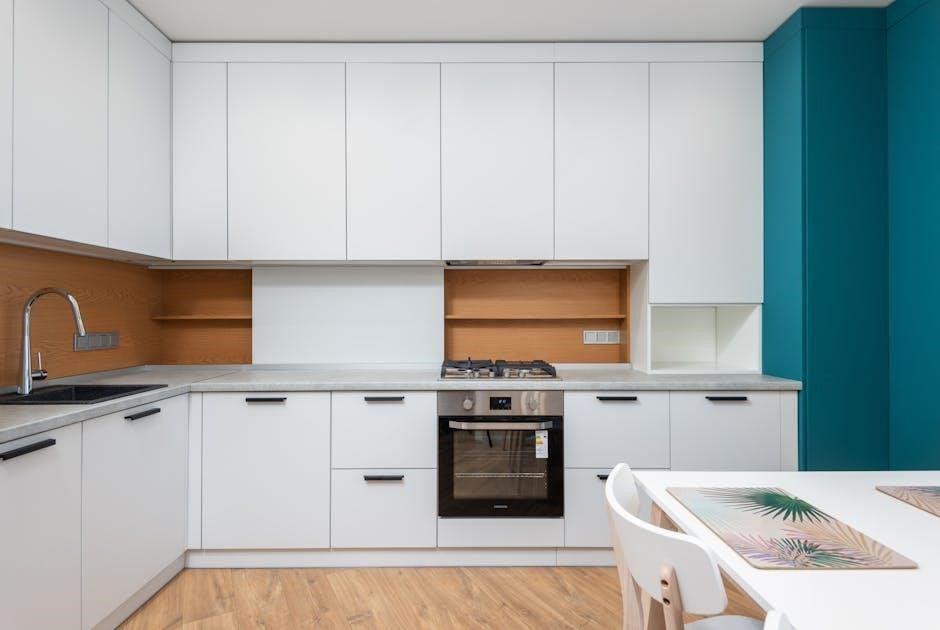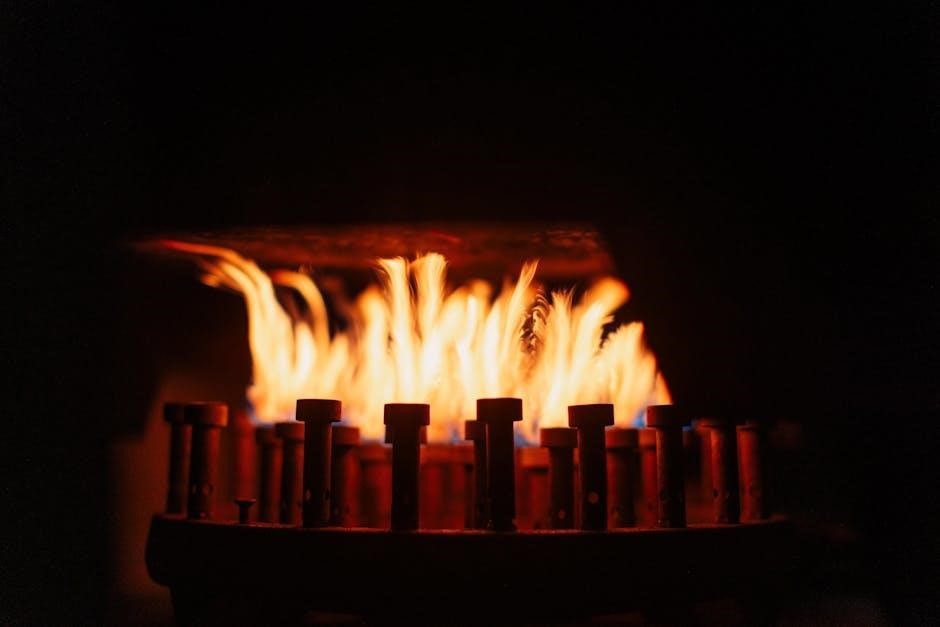This comprehensive guide covers common gas stove issues‚ offering step-by-step solutions for DIY fixes. From igniter problems to gas supply issues‚ we help you troubleshoot efficiently. Ensure safety first!
1.1 Understanding the Basics of Gas Stove Operation
A gas stove operates by channeling gas through burners‚ ignited by an electric spark or pilot flame. The igniter clicks to produce sparks‚ lighting the gas flowing through the burner ports; Proper gas flow‚ ignition‚ and burner function are essential. Regular maintenance‚ like cleaning burners and checking connections‚ ensures safe and efficient operation. Troubleshooting begins with understanding these fundamental components and their roles in the stove’s operation.
1.2 Importance of Regular Maintenance
Regular maintenance is crucial for optimal gas stove performance and safety. Cleaning burners and igniters prevents clogs and ensures proper ignition. Inspecting gas lines and connections reduces leak risks. Scheduling professional inspections annually helps identify hidden issues. Neglecting maintenance can lead to inefficient cooking‚ higher energy bills‚ and potential hazards like gas leaks or fires. By staying proactive‚ you extend the stove’s lifespan and maintain reliability‚ ensuring a safe and efficient cooking experience for years to come.
1.3 Safety Precautions When Troubleshooting
When troubleshooting your gas stove‚ safety is paramount. Always turn off the stove and let it cool before attempting repairs. Ensure the gas supply is disconnected to prevent leaks. Never use open flames or sparks near the stove during inspections. If you smell gas‚ ventilate the area immediately and avoid igniting anything. Wear protective gloves and eyewear when handling sharp or electrical components. If unsure about a repair‚ consult a professional to avoid accidents or further damage. Remember‚ safety should always come first to prevent hazards like fires or gas poisoning.

Common Issues with Gas Stoves
Gas stoves often face issues like burners not lighting‚ uneven or yellow flames‚ gas odors without ignition‚ and inconsistent performance after cleaning cycles. These problems can stem from clogged ports‚ faulty igniters‚ or gas supply disruptions. Identification and quick fixes are essential to restore functionality and safety. Persistent issues may require professional intervention to ensure proper repair and avoid hazards.
2.1 Burners Not Lighting or Clicking Continuously
When burners fail to light or click continuously‚ it often indicates an issue with the igniter or gas supply. The clicking sound suggests the igniter is functioning but not sparking properly. Check for food debris or moisture blocking the igniter. Ensure gas valves are fully open and connections are secure. If the problem persists‚ inspect the igniter for wear or damage. Cleaning the igniter or replacing it may resolve the issue. Always ensure safety by turning off the gas supply before attempting repairs.
2.2 Uneven or Yellow Flames
Uneven or yellow flames on your gas stove can indicate improper combustion or a clogged burner. Yellow flames suggest incomplete gas combustion‚ potentially due to dirt or blockages in the burner ports. To resolve this‚ clean the burner ports with a small brush or toothbrush to remove debris. Ensure the burner cap is properly aligned and securely seated. If the issue persists‚ check the gas pressure settings or consult a professional. Proper flame color should be blue‚ indicating efficient combustion. Regular maintenance can help prevent such issues and ensure safe stove operation.
2.3 Gas Odor but No Ignition
If you smell gas but the stove doesn’t ignite‚ it may indicate a gas leak or an issue with the ignition system. Turn off the gas supply immediately and open windows for ventilation. Check the burner caps for proper alignment and ensure the igniter is clean and functional. If the igniter clicks but doesn’t light‚ it might need replacement. Inspect the gas lines for leaks using a soap solution—bubbles will indicate a leak. If unresolved‚ contact a professional to avoid safety hazards and ensure proper repair. Always prioritize safety when dealing with gas-related issues.
Igniter and Spark Problems
Common issues include faulty spark production‚ dirt buildup‚ or misaligned igniter electrodes. Clean the igniter‚ ensure proper alignment‚ and check for voltage issues. If problems persist‚ replace the igniter or spark module to restore proper ignition function.
3.1 Igniter Clicks but Doesn’t Light
If the igniter clicks but doesn’t light‚ it may indicate a clogged burner port‚ moisture interfering with the spark‚ or a misaligned igniter. Turn off the stove‚ let it cool‚ and clean the burner ports with a toothbrush or small needle. Ensure the igniter is dry‚ as moisture can prevent ignition. If the issue persists‚ check the igniter’s alignment and ensure it’s sparking near the gas ports. If none of these steps work‚ the igniter may need replacement. Always prioritize safety when troubleshooting ignition issues.
3.2 Cleaning or Replacing the Igniter
Cleaning the igniter is essential to maintain proper function. Turn off the stove and unplug it for safety. Use a small brush or toothpick to remove food debris and grime from the igniter. Avoid using harsh chemicals or abrasive materials that could damage the component. If cleaning doesn’t resolve the issue‚ inspect the igniter for wear or damage. Replacement igniters are available and can be installed by following the manufacturer’s instructions. Ensure the new igniter is compatible with your stove model for optimal performance. Regular maintenance helps prevent ignition problems.
3.3 Checking Igniter Voltage
To ensure the igniter is functioning correctly‚ check its voltage using a multimeter. Turn on the stove and measure the voltage at the igniter terminals. A healthy igniter typically reads between 3-5 volts. If the voltage is low or absent‚ the issue may lie in the ignition module or wiring. Ensure all connections are secure and free from corrosion. If the problem persists‚ consult a professional to avoid safety hazards. Proper voltage ensures reliable ignition and prevents gas buildup. Always unplug the stove before performing electrical checks for safety.

Burner-Specific Troubleshooting
Address burner issues like uneven flames or clogs by cleaning ports and ensuring proper gas flow. Repositioning the igniter may resolve misalignment problems. Regular maintenance prevents blockages.
4.1 Burners Not Producing Gas
When burners fail to produce gas‚ ensure the supply valve is fully open and check for blockages in the gas line. Inspect for visible damage or kinks that might restrict gas flow. Clean the burner ports with a small brush to remove debris or residue. Verify the igniter is clicking when the knob is turned‚ as a non-sparking igniter can prevent gas release. Consider priming the gas lines by allowing gas to flow briefly before ignition. If issues persist‚ consult a professional for safe resolution.
4;2 Clogged Burner Ports
Clogged burner ports are a common issue causing uneven flames or ignition problems. To resolve this‚ shut off the gas supply and let the burners cool. Clean the ports using a small brush or toothpick to remove debris. Soak the burner caps in warm soapy water to dissolve tough residue. Dry thoroughly before reinstalling. Regular maintenance by cleaning ports and caps prevents future clogs and ensures proper gas flow. If clogs persist‚ consider replacing the burner assembly to restore optimal performance and safety.
4.3 Repositioning the Igniter
Repositioning the igniter can help resolve issues where the burner isn’t lighting properly. Turn off the gas supply and allow the stove to cool. Gently remove the burner cap or grates to access the igniter. Use a screwdriver to adjust the igniter’s position‚ ensuring it aligns with the burner ports. Make sure the igniter is close enough to the gas flow for proper ignition. After repositioning‚ test the burner to confirm it lights evenly. Regularly inspect and adjust the igniter to maintain optimal performance and prevent ignition problems.

Oven and Broiler Issues
Oven and broiler problems often stem from igniter malfunctions or gas flow issues. Check for proper ignition‚ ensure gas lines are clear‚ and test error codes for specific faults.
5.1 Oven Not Heating or Igniting
If your oven isn’t heating or igniting‚ check the igniter for proper function. Ensure the gas valve is fully open and test for voltage at the igniter. Clean food debris from burner ports and verify gas line connections. If issues persist‚ inspect error codes or consult a professional‚ as faulty ignition modules or gas leaks may require expert attention. Always prioritize safety when diagnosing and repairing oven-related issues.
5.2 Broiler Not Functioning Properly
If the broiler isn’t working‚ first check if the igniter is clicking and functioning properly. Ensure gas flow is steady and unobstructed. Clean burner ports and verify gas line connections; If the broiler igniter is faulty‚ it may need replacement. Check for error codes or lights on the stove’s display‚ which can indicate specific issues. If troubleshooting doesn’t resolve the problem‚ consider consulting a professional to diagnose and repair complex faults. Regular maintenance and proper cleaning can help prevent broiler malfunctions and ensure safe‚ efficient operation.
5.3 Oven Catalytic Cleaning Problems
If your oven’s catalytic cleaning feature isn’t working‚ check for blockages in the burner ports or igniter issues. Ensure gas flow is consistent and unobstructed. After a catalytic clean cycle‚ some users report intermittent ignition problems. Verify that the oven igniter is functioning properly and clean it if necessary. If the issue persists‚ inspect the gas lines for leaks or damage. Resetting the stove or consulting the user manual may resolve the problem. If not‚ professional assistance may be required to address faulty components or complex system malfunctions.

Gas Supply and Connection Problems
Identify issues with gas flow by checking connections for leaks or blockages. Improperly connected lines or clogged ports can disrupt ignition. Resetting the stove or priming gas lines may resolve the issue. Always ensure connections are secure and free from damage to maintain safe and efficient operation.
6.1 Checking Gas Line Connections
Ensure gas line connections are secure and free from leaks or blockages. Turn off the gas supply before inspecting. Check for visible damage or loose fittings. Apply soapy water to detect leaks—bubbles indicate gas escape. Tighten all connections firmly. If issues persist‚ consider professional assistance to avoid hazards. Properly secured lines ensure safe and consistent gas flow to your stove‚ preventing ignition problems and potential safety risks.
6.2 Gas Leaks and Detection
Detecting gas leaks is critical for safety. Smell rotten eggs‚ hear hissing‚ or see bubbles in soapy water on connections—these indicate leaks. Turn off the gas supply immediately and ventilate the area. Never use electrical devices nearby. Inspect lines for damage or loose connections. Tighten fittings if possible‚ but if leaks persist‚ shut off the supply and call a professional. Regular inspections and maintaining secure connections prevent leaks‚ ensuring safe stove operation and avoiding potential hazards like explosions or carbon monoxide exposure.
6.3 Priming Gas Lines
Priming gas lines ensures proper gas flow after maintenance or disconnection. Turn off the stove and gas supply. Open a burner and light it to release air. Repeat for all burners to clear airlocks. If gas doesn’t flow‚ check connections for leaks or obstructions. Prime lines slowly to avoid air pockets. Ensure all valves are fully open. If issues persist‚ consult a professional. Regular priming prevents operational hiccups and ensures your stove runs smoothly and safely‚ avoiding ignition problems or uneven flames.

Electrical and Ignition System Issues
Identify issues in your gas stove’s electrical system‚ such as faulty ignition modules‚ wiring problems‚ or voltage mismatches. Ensure connections are secure and test voltage levels. Addressing these problems can restore proper ignition and function.
7.1 Faulty Ignition Modules
A faulty ignition module can prevent your gas stove from lighting properly. If the module fails‚ you may hear clicking sounds without ignition. This issue often arises from wear and tear or electrical malfunctions. To diagnose‚ check for loose connections or corrosion in the module. Testing the voltage to the module can confirm if it’s receiving power. If the module is defective‚ replacing it is usually the solution. Always ensure the stove is disconnected from power before attempting repairs. If unsure‚ consult a professional to avoid safety risks and ensure proper functionality.
7.2 Checking Electrical Connections
Ensure all electrical connections to your gas stove are secure and free from corrosion. Loose wires or faulty connections can disrupt the ignition system. Turn off the power supply before inspecting. Use a multimeter to test for continuity in wires and connections. Clean any corrosion with a soft brush or replace damaged wires. Verify that the ignition module is properly connected to the burners. If issues persist‚ check the circuit breaker or fuse box. Always unplug the stove before performing electrical checks to avoid shocks or further damage.
7.3 Voltage Issues with Ignition
Voltage issues can prevent the ignition system from functioning properly. Check the voltage at the igniter socket using a multimeter to ensure it matches the manufacturer’s specifications. Low voltage or power fluctuations may cause intermittent ignition. Verify that the stove is connected to a dedicated circuit with the correct polarity. If voltage is inconsistent‚ inspect wiring for damage or loose connections; Consult a licensed electrician if faulty wiring is suspected. Always unplug the stove before performing electrical checks to ensure safety and avoid further damage to components.

Error Codes and Diagnostic Lights
Modern gas stoves display error codes to identify issues. Codes like E1 or E3 indicate specific problems‚ such as ignition faults or gas supply issues. Always reference your stove’s manual to decode and resolve errors effectively‚ ensuring safe and proper repairs.
8.1 Common Error Codes on Gas Stoves
Gas stoves often display error codes like E1‚ E3‚ or E5‚ indicating specific issues. E1 typically points to ignition failure‚ while E3 may signal a gas supply problem. Other codes like E7 or E9 could relate to sensor malfunctions or improper connections. Always consult your stove’s manual for code meanings‚ as they vary by model. Troubleshooting steps may include resetting the stove‚ checking gas lines‚ or cleaning sensors. If unresolved‚ contact a professional to ensure safety and proper repairs. Understanding these codes helps diagnose issues efficiently and prevents further complications. Regular maintenance can reduce error occurrences.
8.2 Resetting the Stove After an Error
To reset your gas stove after an error‚ turn it off and unplug it for 10-15 minutes. This allows the system to clear any glitches. After restarting‚ check if the issue persists. If error codes reappear‚ ensure all connections are secure and vents are clear. Some models may require pressing and holding specific buttons to reset. Always refer to your stove’s manual for model-specific instructions. If the problem remains unresolved‚ contact a professional to diagnose and fix the issue safely and effectively.

Routine Maintenance Tips
Regular cleaning of burners and igniters prevents clogs. Inspect gas lines for leaks and damage. Schedule annual professional inspections to ensure optimal performance and safety.
9.1 Cleaning Burners and Igniters
Clean burners and igniters regularly to prevent clogs and ensure proper ignition. Use a soft brush or toothbrush to remove food debris. Soak burner caps in warm soapy water. For tough grime‚ mix baking soda and water‚ apply‚ and let sit before rinsing. Dry thoroughly before reinstalling. Avoid harsh chemicals to prevent damage. Regular maintenance enhances efficiency and safety‚ keeping your stove in optimal condition. Consistent cleaning reduces the risk of ignition issues and ensures consistent flame performance.
9.2 Inspecting Gas Lines for Damage
Regularly inspect gas lines for leaks‚ cracks‚ or damage to ensure safe operation. Turn off the gas supply before inspection. Apply soapy water to connections; bubbles indicate a leak. Check flexible lines for signs of wear. If damage is found‚ replace the lines immediately. Ensure all connections are tight and secure. If unsure‚ consult a professional. Regular inspections prevent gas leaks‚ reducing safety risks and ensuring efficient stove performance. Always prioritize safety when handling gas lines to avoid potential hazards.
9.3 Scheduling Professional Inspections
Regular professional inspections are crucial for maintaining your gas stove’s safety and efficiency. Schedule annual checks with a certified technician to identify hidden issues‚ such as internal component wear or gas line damage. Experts can address complex problems beyond DIY fixes‚ ensuring compliance with safety standards. Annual inspections prevent unexpected breakdowns and extend the stove’s lifespan. Don’t wait until issues arise; proactive maintenance guarantees reliable performance and peace of mind for years to come.

When to Call a Professional
- Contact a professional for complex issues like persistent gas leaks or faulty ignition systems.
- Seek expert help if DIY solutions fail or safety risks arise.
- Ensure proper repairs for long-term efficiency and safety.
10.1 Complex Issues Beyond DIY
Some gas stove problems require professional expertise‚ such as internal component malfunctions‚ gas line leaks‚ or electrical system faults. DIY attempts can worsen issues or pose safety risks. Always call a certified technician for complex repairs to ensure safety and compliance with appliance standards. Additionally‚ if you encounter recurring problems despite troubleshooting‚ it’s best to seek expert assistance. Remember‚ safety should never be compromised when dealing with gas appliances. A professional will diagnose and fix issues efficiently‚ preventing future complications and ensuring optimal stove performance. They have the tools and knowledge for intricate repairs‚ guaranteeing reliability and safety.
Certain gas stove issues‚ like gas leaks or faulty ignition systems‚ pose significant safety risks. If you smell gas‚ hear hissing‚ or notice inconsistent flames‚ immediate professional intervention is crucial. DIY repairs in such cases can lead to accidents or explosions. Always prioritize safety by contacting a licensed technician for these critical issues. They are equipped to handle hazardous situations and ensure your stove operates safely. Never attempt to fix potentially dangerous problems yourself‚ as this could result in severe consequences. Expert help is essential to protect your home and family from potential harm. Regular cleaning and inspections can prevent gas stove issues. Clear burner ports‚ check for gas leaks‚ and ensure proper ignition function to maintain efficiency and safety. Schedule annual professional inspections to catch potential problems early‚ reducing the risk of unexpected breakdowns and ensuring your stove operates optimally for years. Additionally‚ avoid overloading burners and keep the area around the stove clear of flammable materials to enhance safety and performance. By adopting these preventive measures‚ you can extend the lifespan of your gas stove and enjoy reliable cooking experiences. Consistent maintenance also helps in identifying worn-out parts before they cause major issues. This proactive approach not only saves time and money but also ensures a safer cooking environment for everyone. Lastly‚ always follow the manufacturer’s guidelines for care and maintenance to uphold your stove’s performance and durability. Regular cleaning of burner ports is essential to prevent clogs. Use a small brush or toothbrush to remove food debris and grime. Avoid using abrasive materials that may damage the ports. Ensure the area around the burners remains clean to prevent dust and spills from accumulating. Check ports periodically for blockages‚ especially after spills or heavy use. Clearing clogged ports can often resolve issues like uneven flames or ignition problems. For stubborn clogs‚ soak the burner caps in warm soapy water before scrubbing. This maintenance ensures proper gas flow and efficient stove performance. Regular cleaning also helps prevent gas leaks and ensures safety. If clogs persist‚ consider professional assistance to avoid further complications. By maintaining clean ports‚ you can extend the lifespan of your gas stove and enjoy consistent cooking results. This simple preventive measure saves time and money in the long run. Preventing gas leaks is crucial for safety and efficiency. Regularly inspect gas line connections and ensure they are tight. Use a soapy water solution to detect leaks—bubbles indicate a gas escape. Replace worn-out hoses and gaskets promptly. Always turn off the gas supply when not in use. Ensure proper installation by a licensed professional to avoid faulty connections. Store flammable materials away from the stove. If you suspect a leak‚ open windows and avoid sparks. Regular maintenance and inspections can prevent gas leaks‚ ensuring a safe and reliable cooking experience. Addressing issues early prevents potential hazards and costly repairs. To extend the lifespan of your gas stove‚ regular cleaning is essential. Remove food debris and grease buildup to prevent clogged burners and ports. Check gas line connections for tightness to avoid leaks. Use the correct cookware size to avoid damaging the burners. Avoid using high flame settings excessively‚ as they can wear out components faster. Ensure proper ventilation to prevent moisture buildup. Schedule annual professional inspections to identify and address potential issues early. By maintaining your stove diligently‚ you can ensure it operates efficiently and lasts for many years. Consistent care prolongs its durability and performance. This guide provides essential tips for troubleshooting and maintaining your gas stove. Regular cleaning‚ prompt repairs‚ and safety awareness ensure efficient and safe cooking experiences. Identify common symptoms like burners not lighting or uneven flames. Check gas supply lines‚ igniter functionality‚ and electrical connections. Clean burner ports and igniters regularly. For ignition issues‚ ensure proper voltage and spark production. Address gas leaks promptly and verify proper connections. Preventive maintenance‚ such as cleaning and inspecting components‚ extends stove lifespan. Always prioritize safety and consider professional help for complex problems. By following these steps‚ you can efficiently diagnose and resolve most gas stove issues‚ ensuring safe and optimal performance. Always turn off the stove when not in use and ensure proper ventilation. Regularly clean burners and igniters to prevent clogs and maintain efficiency. Check gas connections for leaks and tighten them if necessary. Keep flammable materials away from the stove. Never leave cooking unattended and monitor children nearby. Schedule annual professional inspections for hidden issues. Follow the manufacturer’s guidelines for maintenance and repairs. By prioritizing safety and upkeep‚ you can enjoy reliable performance and extend the lifespan of your gas stove.10.2 Safety Concerns Requiring Expert Help

Preventive Measures
11.1 Avoiding Clogged Ports
11.2 Preventing Gas Leaks
11.3 Extending the Lifespan of Your Stove
12.1 Summary of Key Troubleshooting Steps
12.2 Final Tips for Safe and Efficient Use